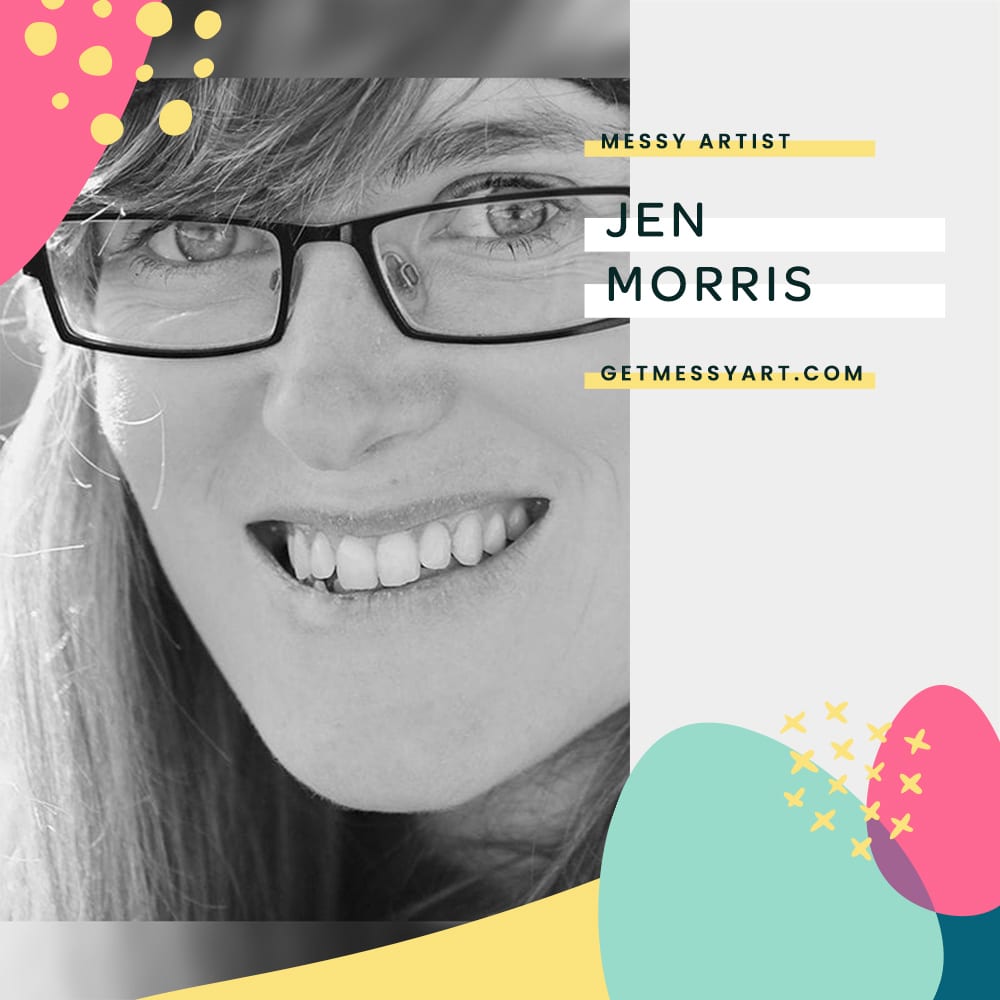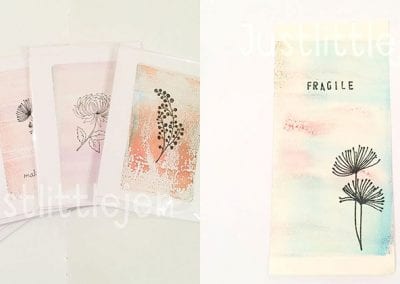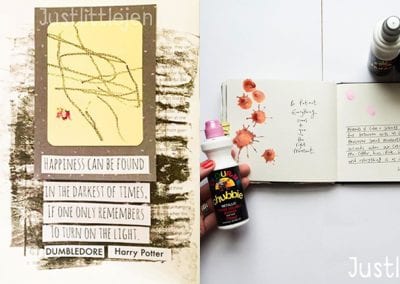Artist Spotlight
How Art Journaling Helps Jen Morris Keep Her Mind Distraction Free

Multi-crafting mama of two
Why do you love art journaling?
Art Journaling lets me take a few precious minutes to do a little creative playing just for me. I love that it can be a private or a public thing, no pressure! I don’t have to show anyone, or create for any purpose. Also I can share special pages with our lovely Get Messy Community, who offer encouragement, support and inspiration! I can experiment with new techniques, new materials or just create *something*. This can be just a lovely way to unwind or as a welcome distraction through a challenging time. My sketchbooks let me explore words, colours and imagery my own way. I love that!
Describe your art journaling process?
My process starts at nap/bedtime for my nearly 2-year old. I usually get prompted by an overheard word, or an image in a magazine, pretty papers or a new technique I have seen on Pinterest. The thought can linger for a while until it becomes an obsession, or I can just do it with no planning. Those are usually my favourite kind of pages! I’m a technique butterfly, I flit from styles, techniques (papercutting/lino/printing/collage/watercolour)
What tips do you have for beginners?
A blank page can be really intimidating. If I’m feeling brave I will cover it with a texture (like using a brayer/roller to spread acrylic paint) or if not so brave I will experiment with placing papers, drawings, stickers etc. and move them around in layers until I’m happy and get out the glue stick! It all depends on what mood I’m in that day. I had a minimalist phase, now I’m in a painty, printing phase!
What do you do when you don’t know what to make?
I look back through my sketchbooks (even my art college work) or I check up with the Get Messy blog/members on Instagram. Inspiration can strike from anywhere, go with it!
What are your must have supplies? What is your journal of choice?
A glue stick, some scissors, some cheap paints (watercolours and acrylic) papers and a good fine line pen. Everything else is just a bonus!
As for a journal, I find larger books can be overwhelming for me at times… I tend to use a little square sketchbook.
Although I am dipping into different journals here and there when I need a new layout/size/challenge, I am currently using a kraft page sketchbook for my 2016 project, an altered gardening book, and have some cheap A5 sketchbooks from Hobbycrafts (UK version of Hobby lobby?) that have watercolour paper in, which are ideal for smaller seasons/ projects.
Your hand lettering. You are an absolute master. How do you manage to have unique hand lettering when it is such a strong trend?
That’s very kind of you to say! I have always had my “arty” writing that I used for greetings cards etc, which is quite a neatly printed style. Mostly I just write without planning it too much and I like writing on lines sometimes, so a free hand line (painted or drawn) helps me to anchor letters in space. I’m not sure what my style is… again, its just how I feel on that day. My “real” everyday writing is more loopy and joined… There is so much inspiration out there, beautiful Brush script, calligraphy… I love Olive and Polka Dot styles, also our own Karen has a beautiful natural hand lettering style too.

✨ Free class for creatives ✨
In How to Start Art Journaling, we’ll walk you through the art of art journaling, including how to start doing (🙌) and make your very first art journal page (even if you’ve never even opened an art journal before).
Tell us more about your potato printing project! How do you find inspiration for this? Do you go looking for it or do you simply play around and see what looks good?
Well, funnily enough, this project started off on Whats App… as Karen and Sharon (aka Nullsie) and I wished to do an online distance learning Printmaking course. We researched it and found that the courses were hugely expensive and Nulls piped up that if we looked on YouTube and Pinterest we could do it ourselves! So each week we choose a new method to explore at our leisure and try it out, hence the hashtag #gmprintomaniacs was born. I do have an old faithful fall back onto baby new potatoes, I just love shape and texture from such a cheap commodity that everyone has in their house! We have tried different veggies, plastic bags, bubblewrap, gelliprints, and all sorts of found objects to make various one of a kind monoprints.
How do you use the gelli plate? How would someone get started down this avenue of art?
I use a tiny Gelli plate which is perfect for small, greetings card sized prints. My first experiments were using ancient (10+ years) stamping inkpads, with a brayer/roller straight onto the plate itself. The ink seemed to bead and produce a lovely watercolour effect. I cleaned my roller between each application of colour and let the colours mix on the plate, otherwise the inkpads would cross contaminate. Once I have that watercoloured print, I then found delicate and pretty floral clear stamps to print in black over the top.
Next I tried using acrylics, applied in blobs straight on the plate. Then I placed a textured piece of card on to the plate, and pulled it off to create a base print. (I found the more successful base layers were lighter colours). I put down a paper heart shape and used it as a mask. I cleaned off the plate and added two/three darker colours in blobs directly onto the gelli plate, rollered it, pressed on a textured piece of card (embossed with my BIG SHOT machine ) pulled it away and placed my base print back on to the inked/textured plate. Pretty “ghost” prints (second print from the same plate) mean there is very little wastage. Each print is wholly unique. I love that.
WARNING: This is seriously addictive. I think the gelli plates are available on Amazon/local craft sites, and there is so much inspiration on the web. I would recommend following @Gelliarts on Instagram.
You seem like you are so free with your art and it’s so inspiring and encouraging. How do you release barriers and simply create?
Thank you, I would say do it for yourself. Be completely open to the fact that things may not look quite as you had imagined in your head, and that is completely ok.
How do you encourage kids getting messy? Why do you think it is important for a child to grow up with creativity and art?
I encourage my nearly 2 year old to play with wax crayons, chubby stamper pens, a painty roller, printing making set from the Pound shop and Paint….he just LOVES the paint. I used to take him to weekly baby art classes which have since closed down, but it made me confident with setting up a painting station and letting him discover his own art, himself.
Painting with toddlers sounds like a nightmare…..but it doesn’t have to be.
I lay out a big messy plastic sheet in the bathroom (stay with me-it will make sense I promise!) Run a bath and set up the paints. Then I strip my little one down to a nappy and just let him loose. Once he’s had enough, I pop him into the bath and I can tidy up whilst he is splashing and “cleaning” his little painty self!
He has his own sketchbook, and often collaborates with me in my journal. It is important that he sees me creating in my journals and naturally, he wants to do the same.
As a Teaching Assistant, I often hear kids say they are “no good at art” and that just breaks my heart. I love the childlike excitement of mixing paints and experimenting – I hope I instil a passion within the children I work alongside by making art sessions fun and productive. They are so proud when they make something that they have enjoyed creating. #getmessywithlittleones
Thank you so much for asking me to take part in the spotlight feature. I am so lucky to have stumbled upon such a supportive and creative group of friends who encourage and inspire me. (and send lovely things in getmessystashswaps!)
📌 Pin this or share in Instagram Stories:



Jen Morris
Multi-crafting mama of two






